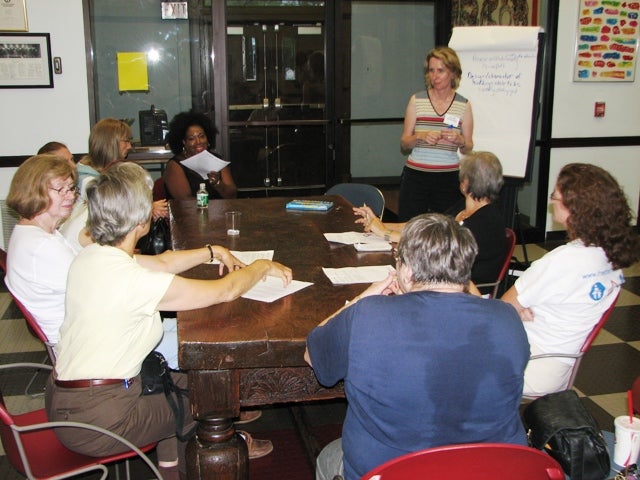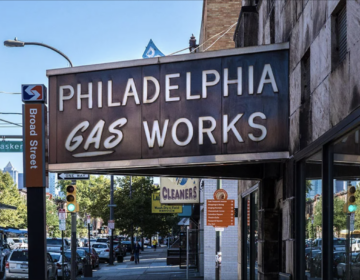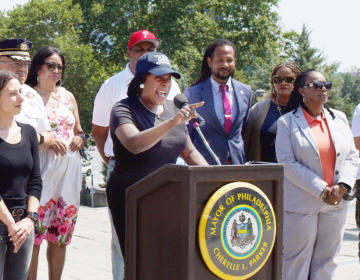Planning feedback South Philadelphia style

Aug. 2
By Alan Jaffe
For PlanPhilly
Fear of casinos and condos brought many of the 100 people to the civic feedback session at the Settlement Music School in South Philadelphia on Thursday evening. But at least some of them left with a feeling that the battle for the Delaware riverfront wasn’t lost yet.
PennPraxis, the clinical arm of the University of Pennsylvania design school, coordinated the presentation updating residents on the Central Delaware waterfront plan and the small-group responses to the proposals. Harris Sokoloff, who leads the Penn Project on Civic Engagement, said the planning process was about two-thirds complete. The plan that will be presented in November to the current mayor and his probable successor is a “citizen vision” driven not by a group of designers but by “the values, dreams and hopes” of Philadelphia residents.
Nando Micale, an urban designer with the firm WRT, presented the “citizen vision” thus far, consisting of three frameworks built on a boulevard running the length of the seven-mile stretch, open space that includes an esplanade and a series of parks, and mixed-use development.
“Now it’s a matter of understanding what’s possible and what’s far- fetched but achievable,” Micale said.
In the southern section that begins at Oregon Avenue and goes north, Micale presented a map that extends a dense street grid down to the waterfront and “reinforces a sense of being in Philadelphia” rather than big-box suburbia.
In the central section, he explained the “big idea” born in the March designers’ workshop to bury a portion of Interstate 95 and bring the city down to the waterfront. “The idea is to view Penn’s Landing as the sixth square,” an extension of Center City.
In the northern section reaching to Allegheny Avenue, the plan calls for the creation of open space, a new stormwater management system, and a remaking of the Girard Avenue Interchange of I-95.
Micale concluded with a series of photos of other cities’ projects that incorporated industrial ruins, re-imagined old piers as parks and recreational opportunities, and brought grandeur and civic pride to their riverfronts.
In one of seven small groups that were broken out to respond to the proposals, Megan Fitzpatrick expressed the optimism that seemed to percolate after Micale’s presentation. “This is giving us a structure,” she said. The city has needed a plan that is not anti-development but takes into account the desires of neighborhood groups, she said.
Many echoed the belief that waterfront development has proceeded in recent years without a plan, and has led to a proposed wall of condo towers bookended by casinos.
One casino opponent, South Philadelphia resident Marjorie Rosenblum, said, “I’m here because I fear that Foxwoods will steal the riverfront from the people.”
Amy Michal, a member of Casino Free Philadelphia, said the current projects along the Delaware are a “hodgepodge of development. Let’s get something on the boards before the politicians screw everything up,” she said.
But Michal also said “positive things are happening.” A new zoning commission, a new mayoral administration on the horizon, and the unification of community groups could determine the direction for the waterfront.
When the small groups reconvened as one, they reviewed their ideas that were inspired by the PennPraxis proposals.
Scott Maits, who had operated an antique trolley that ran up and down Delaware Avenue, supported the notion of updated transportation infrastructure and a new light rail system along the waterfront.
Others suggested the introduction of solar, wind and perhaps tidal power technologies along the river. Many emphasized the need for entertainment and social gathering spots along the boulevard.
Most welcomed the idea of small-scale retail and residential development, but they said the neighborhoods required schools, social services, and plenty of affordable housing, not just multi-million- dollar high-rises.
Another common response to the plans presented at the music school was skepticism that state and city politicians would follow through on the proposals. “What’s in the way are Philly in-your-pocket politicians,” said Merilyn Jackson, a veteran of other battles to keep highways out of Center City.
“I want to see that [the PennPraxis plan] has some teeth that can make it happen, and happen pretty fast,” Jackson said.
At the evening’s conclusion, Sokoloff said the planning process has generated public and civic will, but “it needs constant civic attention.” Citing the 3,500 residents and designers who have participated so far in the process, the eventual adoption of the plan and the creation of a new zoning code, he said, “We’re growing teeth.”
WHYY is your source for fact-based, in-depth journalism and information. As a nonprofit organization, we rely on financial support from readers like you. Please give today.






